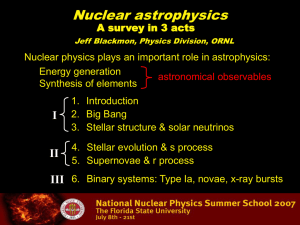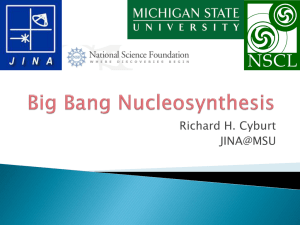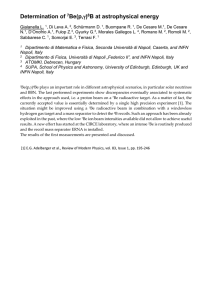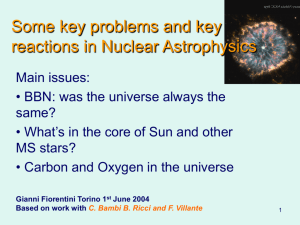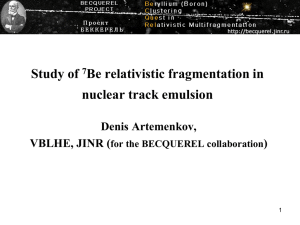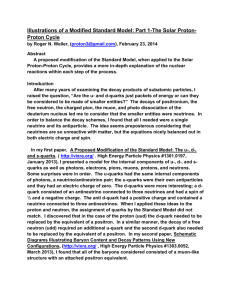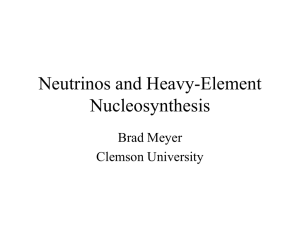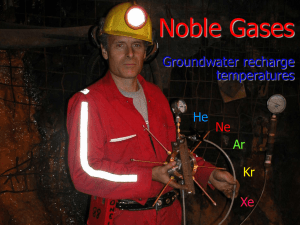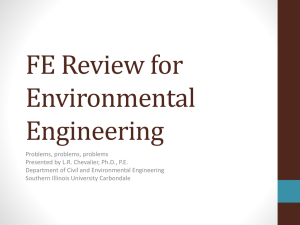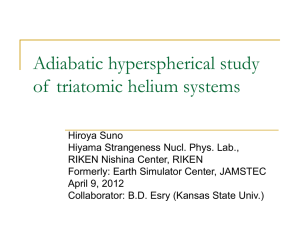Methods to directly measure non-resonant stellar reaction rates
advertisement
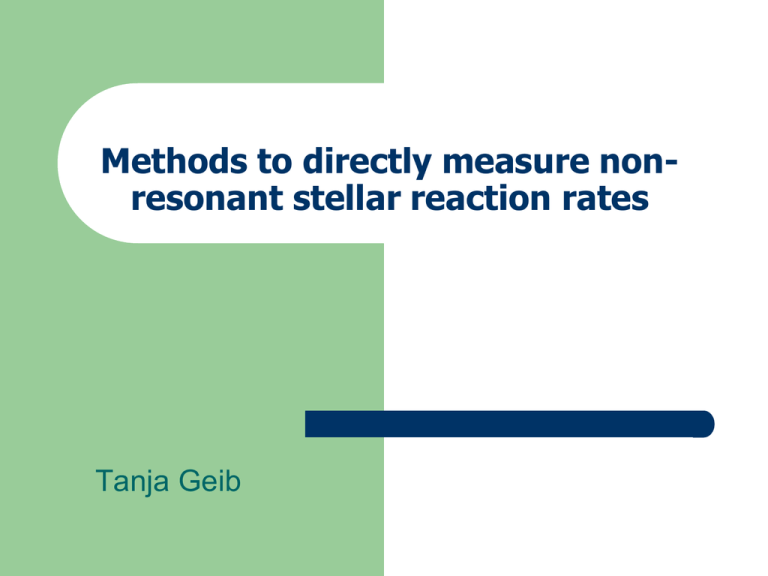
Methods to directly measure nonresonant stellar reaction rates Tanja Geib Outline 1. Theoretical background: – – – – 2. Reaction rates Maxwell-Boltzmann-distribution of velocity Cross-section Gamow-Window Experimental application using the example of the pp2-chain reaction in the Sun – – – – Motivation and some more theory Historical motivation 3He(α,γ)7Be as important onset reaction Prompt and activation method Reaction Rates Nuclear Reaction Rate: particle density of type X reaction cross section flux of particles of type a as seen by particles X Important: this reaction rate formula only holds when the flux of particles has a mono-energetic (delta-function) velocity distribution of just Generalization to a Maxwell-Boltzmann Sun velocity-distribution Inside a star, the particles clearly do not move with a mono-energetic velocity distribution. Instead, they have their own velocity distributions. Looking at the figure, one can see, that particles inside the Sun (as well inside stars) behave like an ideal gas. Therefore their velocity follows a MaxwellBoltzmann distribution. Generalization to a Maxwell-Boltzmann velocity-distribution The reaction rate of an ideal gas velocity distribution is the sum over all reaction rates for the fractions of particles with fixed velocity: Here the Maxwell-Boltzmann distribution enters via Generalization to a Maxwell-Boltzmann velocity-distribution After some calculation, including the change into CMS, one obtains: 12 is entered to avoid double-counting of particle pairs if it should happen that 1 and 2 are the same species In terms of the relative energy (E=1/2 μv2 ) this means 8 r12 1/ 2 N1 N 2 3 / 2 E E ( E ) exp dE 0 1 12 Cross-Section The only quantity in the reaction rate that we have not treated yet is the crosssection, which is a measure for the probabitlity that the reaction takes place if particles collide. We will now motivate its contributions. • Tunneling/ Transmission through the potential barrier repulsive square-well potential Cross-Section Radial Schrödinger equation for s-waves d 2u 2 2 E V (r ) u 0 2 dr is solved by the ansatz u I A exp(iKx) B exp(iKx) u II C exp(x) D exp(x) u III F exp(ikx) G exp(ikx) This leads to transmission coefficient Tˆ KB kG 2 2 2 exp 2 (V1 E ) ( R1 Ro ) for low-energy s-wave transmission at a squarebarrier potential Cross-Section We generalize this to a Coulomb-potential by dividing the shape of the Coulomb-tail into thin slices of width dr. Total transmission coefficient for s-wave: 2 Tˆ Tˆ1 Tˆ2 ..... Tˆn exp 2 (Vi E ) ( Ri 1 Ri ) i 2 Rc n exp 2 V ( r ) E dr R 0 Reminder: If angular momentum not equal zero, then V(r) V(r) + centrifugal barrier Cross-Section Inserting the Coulomb potential, one obtains: Solving the integral, and again using that the incident s-wave has small energies compared to the Coulomb barrier height, we get: 2 ˆ T exp Z1 Z 2 e 2E 2 Cross-Section •Quantum-mechanical interaction between two particles is always proportional to a geometrical factor: 1 2 E deBroglie wavelength • We account for the corrections arising from higher angular momenta by inserting the “Astrophysical S-Factor” S(E), which “absorbs” all of the fine details that our approximations have omitted. Finally, our considerations lead to defining the cross-section at low energies as: 2 S (E) (E) exp E Z1Z 2 e 2E 2 Cross-Section The figure on the left shows the measured cross section as a function of the laboratory energy 12 of protons striking a C target. The observed peak corresponds to a resonance. 12C(p,g)13N (E) 2 S (E) exp E Z1Z 2 e 2 2E Gamow-Window Entering the cross section into the reaction rate, we obtain: 8 r12 1/ 2 N1 N 2 3 / 2 E b S ( E ) exp dE 1 12 E 0 Z1Z 2e 2 b 2 2 1/ 2 with Using mean value theorem for integration, we bring the equation to the form 8 r12 1/ 2 N1 N 2 3 / 2 E b S0 exp dE 1 12 E 0 to pull out the essential physics/ evolve the Gamow-window. Log scale plot Gamow-Window We know that r12 area under the curve This is where the action happens in thermonuclear burning! This overlap function is approximated by a Gaussian curve: the Gamow-Window. The Gamow-Window provides the relevant energy range for the nuclear reaction. Linear scale plot Gamow-Window A Gaussian curve is characterized by its expectation value E0 and its width : 1/ 3 b E0 1.22 Z12 Z 22 T6 2 keV 2 4 1/ 2 2 2 5 1/ 6 E0 0.75 Z1 Z 2 T6 3 2/3 E0 tells us where we find the Gamow-window. provides us with the relevant energy range. Knowing the temperature of a star, we are able to determine where we have to measure in the laboratory. Astro-Physical S-Factor (12C(p,g)13N) How does S0 look like? A given temperature defines the Gamow-window. For stars, inside the Gamow-window, S(E) is slowly varying. Approximate the astrophysical factor by its value at E0 : S0 S ( E0 ) Nuclear Reactions in the Sun • core temperature: 15 Mio K • main fusion reactions to convert hydrogen into helium: • proton-proton-chain • CNO-cycle • nuclear reactions in the Sun are non-resonant Proton-Proton-Chain 4p 4He + 2e+ + 2n + Qeff Netto: p + p d + e+ + n p + d 3He + g 86% 3He 14% + 3He 4He + 2p 3He 99.7% PP-I Qeff= 26.20 MeV + 4He 7Be + g + e- 7Li + n 7Li + p 2 4He 7Be 0.3% + p 8B + g 8B 8Be + e+ + n 7Be PP-II 2 4He Qeff= 25.66 MeV PP-III Qeff= 19.17 MeV Homestake-Experiment Basic idea: if we know which reactions produce neutrinos in the Sun and are able to calculate their reaction rates precisely, we can predict the neutrino flux. • Same idea by Raymond Davis jr and John Bahcall in the late 1960´s: Homestake Experiment • purpose: to collect and count neutrinos emitted by the nuclear fusion reactions inside the Sun • theoretical part by Bahcall: expected number of solar neutrinos had been computed based on the standard solar model which Bahcall had helped to establish and which gives a detailed account of the Sun's internal operation. Homestake-Experiment • experimental part by Davis: • in Homestake Gold Mine, 1 478 m underground (to protect from cosmic rays) • 380 m3 of perchloroethylene (big target to account for small probabiltiy of successful capture) • determination of captured neutrinos via counting of radioactive isotope of argon, which is produce when neutrinos and chlorine collide • result: only 1/3 of the predicted number of electron neutrinos were detected Solar neutrino puzzle: discrepancies in the measurements of actual solar neutrino types and what the Sun's interior models predict. Homestake-Experiment Possible explanations: • The experiment was wrong. • The standard solar model was wrong. • Reaction rates are not accurate enough. • The standard picture of neutrinos was wrong. Electron neutrinos could oscillate to become muon neutrinos, which don't interact with chlorine (neutrino oscillations). 3He + 4He 7Be + g 99.7% Necessary to measure reaction rates at high accuracy. Here: with the help of 3He(α,γ)7Be as the onset of neutrino- 7Be + e- 7Li + n 7Li + p 2 4He producing reactions 0.3% + p 8B + g 8B 8Be + e+ + n 7Be Motivation We will take a look at the 3He(α,γ)7Be reaction as: The nuclear physics input from its cross section is a major uncertainty in the fluxes of 7Be and 8B neutrinos from the Sun predicted by Solar models As well: major uncertainty in 7Li abundance obtained in big-bang nucleosynthesis calculations Critical link: important to know with high accuracy Measuring the reaction rate of 3He(α,γ)7Be Q= 1,586 MeV 429 keV There are two ways to measure that the 3He(α,γ)7Be reaction occured: • prompt γ method: measuring the γ´s emitted as the 7Be* γ-decays into the 1st excited or the ground state • activation method: measuring the γ´s that are emitted when the radioactive 7Be decays Basic Measuring Idea Experimentally we get the cross section over: exp where: • the yield is the number of γ events counted • NBeam is the number of beam particles counted • ρ is the number of target particles per unit area Yield N Beam Background reduction • underground, at the energy range we are interested in: about 10 h to see one background event surface • using the equation mentioned before, we can approximate that our 3He(α,γ)7Be reaction provides about 70 events an hour. thanks to the shielding: the yield is significantly higher than the background and can therefore be clearly seperated from it Laboratory for Underground Nuclear Astrophysics at Laborati Nazionali del Gran Sasso (LNGS) Luna target accelerator detector Credits to Matthias Junker at LNGS-INFN for making the LNGS picture available Prompt-γ-Method Experimental Set-Up Schematic view of the target chamber Prompt-γ-Method background 1st GS 1st GS signal 1st Measured γ-ray spectrum at Gran Sasso LUNA accelerator facility GS Prompt-γ-Method Overview on available S-factor values and extrapolation Activation Method Experimental Set-Up at Gran Sasso LUNA2 Schematic view of the target chamber used for the irradiations Activation Method Offline γ-counting spectra from detector LNGS1 Activation Method Astrophysical S-factor at lower panel, uncertainties at upper panel Summary Knowing the temperature of e.g. the Sun, we can specify the relevant energy range for a nuclear reaction An important reaction to research the interior of the Sun as well as big-bang nucleosynthesis is 3He(α,γ)7Be Energies related to Sun temperatures are technically not feasible: extrapolation demands high accuracy measurements Necessary to reduce background The weighted average over results of both methods (prompt and activation) provides an extrapolated S-factor of 𝑆 0 = 0.560 ± 0.017 𝑘𝑒𝑉 References Donald D. Clayton, Principles of Stellar Evolution and Nucleosynthesis (University of Chicago Press, Chicago, 1983) Christian Iliadis, Nuclear Phyics of Stars (WILEYVCH Verlag GmbH & Co. KGaA, Weinheim, 2007) F. Confortola et al., arXiv: 0705.2151v1 (2007) F. Confortola et al., Phys. Rev. C 75, 065803 (2007) Gy. Gyürky et al., Phys. Rev. C 75, 035805 (2007) C. Arpesella, Appl. Radiat. Isot. Vol. 47, No. 9/10, pp. 991-996 (1996) D. Bemmerer et al., arXiv: 0609013v1 (2006) Zusatz-Folie ECM mt Ebeam mt mbeam Example: using a α-Beam at an energy of 300 keV, which corresponds to an relative energy of 129 keV accords to a temperature of 207 MK (which is more than ten times higher than in the Sun: need for extrapolation)
